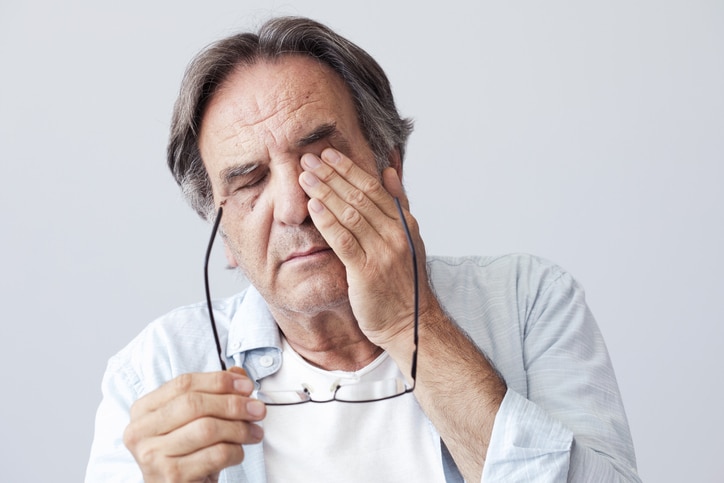
At the Longwood Eye & LASIK Center, we have experience working with a wide degree of different eye-related problems. Dr. Fay and the rest of the accredited staff are equipped and trained to help your eyes achieve the comfort you deserve.
What Is Blepharospasm?
Blepharospasm is defined as an abnormal, involuntary, and forceful closure or twitching of the eyelids. Eyelid twitching is usually associated with a headache, eyebrow strain and occasionally loss of vision.
These eyelid spasms typically affect women 40 to 60 years of age, with 2 to 4 women afflicted for every man affected by the disease. Currently, there are around 50,000 diagnosed cases of blepharospasm in the United States.
Although this is a benign condition, it can be severely disabling with eye pain and functional blindness. There are also reported cases of severe depression associated with severe and disabling blepharospasm so it is important that you contact our office if you are experiencing Blepharospasm symptoms.
Types of Blepharospasms
Blepharospasm occurs in two forms:
- Essential or spontaneous blepharospasm is a rare focal dystonia without any known cause and affects individuals between 45 and 65 years of age. Essential blepharospasm is commonly associated with stress, fatigue or an irritant. The symptoms might possibly be benign and short-term or they might cause significant lifelong challenges to the individual. These symptoms may even cause functional blindness in rare cases.
- Reflex blepharospasm is due to reflex sensory stimulation and is common in conditions like phlyctenular conjunctivitis, interstitial keratitis, corneal foreign body, corneal ulcers and iridocyclitis. Excessive stimulation of the retina by dazzling light, stimulation of facial nerve due to central causes, and some hysterical patients also present with reflex blepharospasm. It is due to any pain in and around the eye.
Blepharospasm Symptoms
The onset of blepharospasm is marked by a gradually progressive increase of blinking in response to stimuli like wind, polluted air, sunlight, noise, movements of the head or eyes, or exposure to any stressful environment. They also present with dry eye symptoms such as photophobia and eye irritation. These symptoms are however relieved by sleep, relaxation, gazing downwards, artificial tears, traction on eyelids, talking, humming or singing.
Initially, it starts in one eye but progresses gradually to involve both eyes and even the facial and neck muscles.

The following symptoms occur during the early stages of blepharospasm:
- Dry eyes
- Increased rate of blinking
- Spasms of the eyelids
- Irritation of the eyes
- Eye pain
- Midfacial or lower facial spasm
- Brow spasm
- Eyelid tic
Anatomic changes are often seen with long-standing blepharospasm. These changes include:
- Ptosis or drooping of the brow and eyelids
- “Baggy eyes” due to loose skin
- Entropion or inward turning of the eyelids
- Canthal tendon abnormalities
How Are Blepharospasms Diagnosed?
Due to its rarity and similarities with other diseases, blepharospasm is often misdiagnosed. The following conditions should be considered in the diagnosis while evaluating a suspected case of blepharospasm:
- Bells Palsy
- Allergic conjunctivitis
- Dacryocystitis
- Eyelid myokymia
- Keratoconjunctivitis sicca
- Non-granulomatous anterior uveitis
Blepharospasm Treatment Options
Patient education, membership in various support groups, pharmacotherapy, botulinum toxin injections, and surgical intervention constitute the best conventional treatments for a patient with blepharospasm. If you are experiencing reflex blepharospasm, you must treat the causative disease to prevent recurrences.

Patient Testimonials
“I have been Dr. John Warren’s patient for almost 2 years. I have always been extremely anxious about doctors and medical appointments. Dr. Warren is the first doctor that I can honestly say I like and trust 100%. He not only saved my vision, but recognized that the problem with my eyes was the sign of a more systemic problem that also needed treatment.”
-Laurie
Management of Eye Twitches
Blocking or reducing sensory stimulation can assist in the management of blepharospasm. A patient may choose to wear tinted UV blocking sunglasses to decrease painful light sensitivity. Irritation of the eyes, dry eyes and blepharitis associated with blepharospasm are alleviated by lid hygiene, frequent application of artificial tears and occlusion of the punctum (tear duct).
Treating Blepharospasms with Botox
Botulinum toxin (BOTOX) has been used to provide relief to patients suffering from numerous stubborn spastic disorders. Some of these disorders include cervical dystonia, strabismus, blepharospasm, and facial nerve disorders.

Why Do You Have to Repeat Botox Treatments For Eye Twitching?
Nerve Sprouting is an interesting phenomenon in which new nerve terminals sprout parallel to the one blocked by botulinum and establishes new neuromuscular junctions. This results in a gradual functional recovery of the neuromuscular junction. This functional recovery takes about 4 to 6 months.
The phenomenon of Nerve Sprouting is important because once functional recovery is complete, repeat injections should be given to maintain the desired clinical effect.
Hence, repeat injections should be given every four to six months based on individual response to therapy.
Schedule A Consultation
The team at the Longwood Eye & LASIK Center has incredible knowledge of the eye and facial anatomy surrounding the eyes. To learn more about Blepharospasm treatment, call 1-855-286-2020 or schedule a consultation online.




